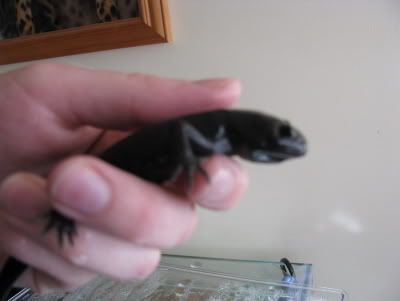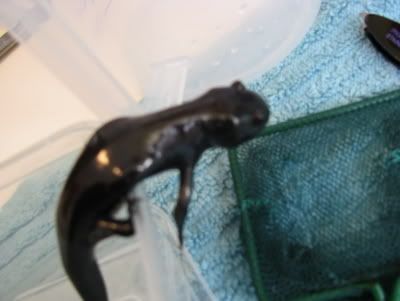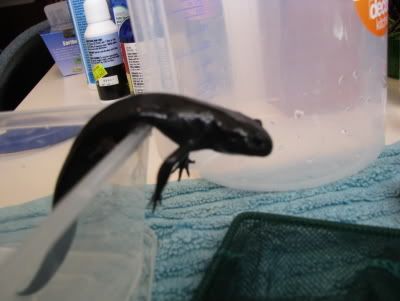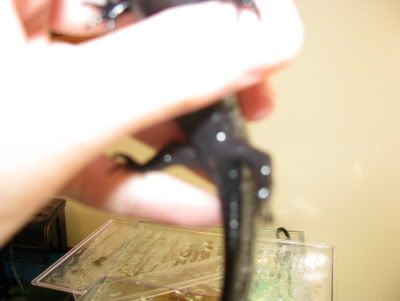Sorry, it seems my first post here will be quite a long one. I've got quite a lot of questions!
I used to work at an aquarium pet store. Anyway, a few weeks ago, we somehow got a few salamanders in stock. At first my manager told me they were newts, but later on he said that they were definately terrestrial axolotls. I don't know the full background story. There was a gorgeous solid black coloured/melanistic one and knowing that I'd probably never get the opportunity again, I decided to do the hypocritical thing and buy her and the tank on the same day (hypocritical because I was constantly telling customers not to do that... not that they ever listened ).
).
Here's a pic of Nessie:
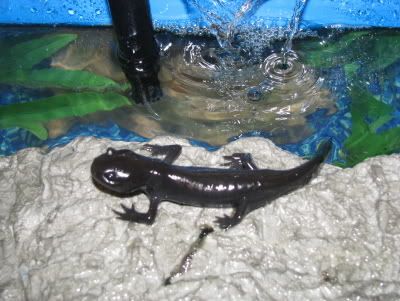
And here's the start of the endless questions!
First of all, she is a melanistic Mexican Salamander, right?
I've been trying to read up on how I should take care of her, but all of the books I've borrowed about axolotls only have a paragraph about the terrestrial form. So unfortunately I've sort of been making up the husbandry as I go along. Currently she's in a tank by herself, with a hang-on filter, 13L of water (temp around 15 to 17 degrees Celcius) with a floating turtle dock. She's quite small, only about 10 to 15cm in size. I've been feeding her once every two days on a rotating diet of bloodworm, beef heart, small crickets and just recently, earthworms.
I've found the page on this website concerning their husbandry, but that has only gotten me more confused. The reason being is that it says that she needs more of a terrestrial set up, however I've witnessed otherwise. When I bought Nessie, there were two other salamanders in the tank (they were temporarily placed in the plant tank - about 300L and quite deep). While Nessie tended to be the one who liked to stay out of the water the most (she hung out near a horizontal filter grate), the other two (who were tan in colour with darker speckles) were perfectly fine in the water. I've seen Nessie stay submerged for a few hours at a time, and I've seen her take a swim in her tank three times now on her own accord. I find that provided she has something to hold onto (like an ornament or plants) she seems quite calm. However if she's just suspended in the water, she does tend to freak out after a while and swim frantically. So despite all that, should I still consider more of a terrestrial set up?
If the answer is yes, then what type of substrate should I buy? Also, how would I clean it? Currently I've been having problems with the ammonia levels in the tank (up to 1ppm), even though it's filtered, had any waste regularly removed (I hand feed her on the turtle dock so nothing should be going into the water) and had 30% water changes. I've also used ammonia detoxifiers, added the bacteria regularly and just recently added a plant that should survive the conditions in order to combat it. So that's why I'm a bit concerned with turning it into a terrestrial set up, because then the water level would be so low that having a filter would be impractical, hence I fear that the ammonia level would then sky rocket.
I've also discovered four different types of excretement:
1) In the water I've scooped out clear little balls with a brown centre. I'm guessing it's the same with axolotls in that it's regurgitated food? I only found it in the first week though.
2) Probably the oddest one - on the ornament, twice I've found a clear-ish moss-like thing, attached by only a few strands. I don't think it's just algae, 'cause it seems to just spring up over night (and also there's very little traces of algae anywhere else).
3) As you can see a bit in the photo, occasionally I find black film-like strands on the turtle dock. Is this skin shedding? It can be picked up in one piece.
4) Once a week I also find on the turtle dock one oval, pea-sized black ball. I'm guessing that this is faecal matter?
Also, should I be feeding her once every three days, not once every two? She's eaten every time, though never the full amount (like only 1/4 of a beef heart cube, 1/2 of a bloodworm cube). Should she be getting food supplements as well, similar with what you have to do with reptiles?
Once again, sorry for the long post! I hope you guys can clear a few things up for me!
I used to work at an aquarium pet store. Anyway, a few weeks ago, we somehow got a few salamanders in stock. At first my manager told me they were newts, but later on he said that they were definately terrestrial axolotls. I don't know the full background story. There was a gorgeous solid black coloured/melanistic one and knowing that I'd probably never get the opportunity again, I decided to do the hypocritical thing and buy her and the tank on the same day (hypocritical because I was constantly telling customers not to do that... not that they ever listened
Here's a pic of Nessie:

And here's the start of the endless questions!
First of all, she is a melanistic Mexican Salamander, right?
I've been trying to read up on how I should take care of her, but all of the books I've borrowed about axolotls only have a paragraph about the terrestrial form. So unfortunately I've sort of been making up the husbandry as I go along. Currently she's in a tank by herself, with a hang-on filter, 13L of water (temp around 15 to 17 degrees Celcius) with a floating turtle dock. She's quite small, only about 10 to 15cm in size. I've been feeding her once every two days on a rotating diet of bloodworm, beef heart, small crickets and just recently, earthworms.
I've found the page on this website concerning their husbandry, but that has only gotten me more confused. The reason being is that it says that she needs more of a terrestrial set up, however I've witnessed otherwise. When I bought Nessie, there were two other salamanders in the tank (they were temporarily placed in the plant tank - about 300L and quite deep). While Nessie tended to be the one who liked to stay out of the water the most (she hung out near a horizontal filter grate), the other two (who were tan in colour with darker speckles) were perfectly fine in the water. I've seen Nessie stay submerged for a few hours at a time, and I've seen her take a swim in her tank three times now on her own accord. I find that provided she has something to hold onto (like an ornament or plants) she seems quite calm. However if she's just suspended in the water, she does tend to freak out after a while and swim frantically. So despite all that, should I still consider more of a terrestrial set up?
If the answer is yes, then what type of substrate should I buy? Also, how would I clean it? Currently I've been having problems with the ammonia levels in the tank (up to 1ppm), even though it's filtered, had any waste regularly removed (I hand feed her on the turtle dock so nothing should be going into the water) and had 30% water changes. I've also used ammonia detoxifiers, added the bacteria regularly and just recently added a plant that should survive the conditions in order to combat it. So that's why I'm a bit concerned with turning it into a terrestrial set up, because then the water level would be so low that having a filter would be impractical, hence I fear that the ammonia level would then sky rocket.
I've also discovered four different types of excretement:
1) In the water I've scooped out clear little balls with a brown centre. I'm guessing it's the same with axolotls in that it's regurgitated food? I only found it in the first week though.
2) Probably the oddest one - on the ornament, twice I've found a clear-ish moss-like thing, attached by only a few strands. I don't think it's just algae, 'cause it seems to just spring up over night (and also there's very little traces of algae anywhere else).
3) As you can see a bit in the photo, occasionally I find black film-like strands on the turtle dock. Is this skin shedding? It can be picked up in one piece.
4) Once a week I also find on the turtle dock one oval, pea-sized black ball. I'm guessing that this is faecal matter?
Also, should I be feeding her once every three days, not once every two? She's eaten every time, though never the full amount (like only 1/4 of a beef heart cube, 1/2 of a bloodworm cube). Should she be getting food supplements as well, similar with what you have to do with reptiles?
Once again, sorry for the long post! I hope you guys can clear a few things up for me!

